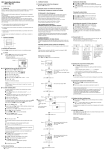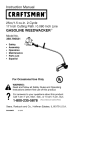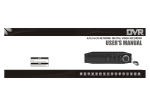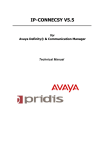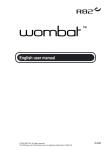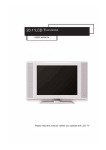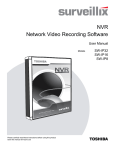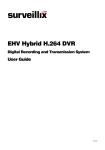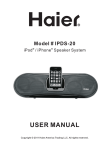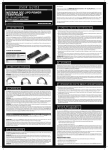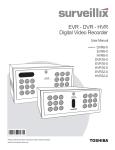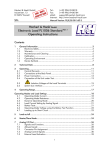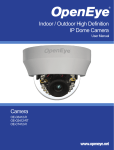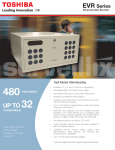Download IKS-WD6112 Operation Manual
Transcript
NETWORK CAMERA Model: IKS-WD6112 User’s Manual For information on our latest products and peripheral devices, refer to the following web site: www.toshibasecurity.com If the URL changes, refer to www.toshiba.com 2 Indoor IP Camera (IKS-WD6112) User Manual Manual Edition 1 – NOVEMBER 2014 ©2014, Toshiba All Rights Reserved. No part of this documentation may be reproduced in any means, electronic or mechanical, for any purpose, except as expressed in the Software License Agreement. Toshibashall not be liable for technical or editorial errors or omissions contained herein. The information in this document is subject to change without notice. The information in this publication is provided “as is” without warranty of any kind. The entire risk arising out of the use of this information remains with recipient. In no event shall Toshibabe liable for any direct, consequential, incidental, special, punitive, or other damages whatsoever (including without limitation, damages for loss of business profits, business interruption or loss of business information), even if Toshibahas been advised of the possibility of such damages and whether in an action or contract or tort, including negligence. This documentation is copyrighted. All other rights are reserved to Toshiba. Surveillix, and Toshiba, are registered trademarks of Toshibain the United States and elsewhere; Windows, and Windows XP Embedded are registered trademarks of Microsoft Corporation. All other brand and product names are trademarks or registered trademarks of the respective owners. Toshiba Irvine, CA●U.S.A. 3 Important Safeguards 1. Read Instructions Read all the safety and operating instructions before operating the product. 2. Retain Instructions Retain the safety instructions and user's manual for future reference. 3. Warnings Comply with all warnings on the product and in the user's manual. 4. Follow Instructions Follow all operating and use instructions. 5. Cleaning Disconnect this camera from the power supply before cleaning. 6. Attachments Do not use attachments not recommended by the camera manufacturer as they may posesafety risks. 7. Water and Moisture Do not use this camera near water. Some examples are: near a bath tub, wash bowl, kitchensink, or laundry tub, in a wet basement, or near a swimming pool. 8. Accessories Do not place this camera on an unstable cart, stand, tripod, bracket or table. The cameramay fall, causing serious injury to a person, or serious damage to the product. Use only withstand, tripod,bracket,or table recommended by the manufacturer, or sold with the camera.Any mounting of the product should follow the manufacturer's instructions, and should use amounting accessory recommended by the manufacturer. 9. Ventilation This camera should never be placed near or over a radiator or heat register. If this productis placed in a built-in installation, verify that there is proper ventilation so that the cameratemperature operates within the recommended temperature range. 10. Power Sources This camera should be operated only from the type of power source indicated on theinformation label. If you are not sure of the type of power supply at your location, consult yourproduct dealer. 11. Power-Cord Protection Power cords should be routed so that they are not likely to be walked on or pinched by itemsplaced upon or against them. Pay particular attention to cords at plugs, screws and the pointwhere they exit the product. 12. Installation Install this camera on a secure part of the ceiling or wall. If installed on an unsecured location the camera could fall causing injury and damage. 4 13. Lightning For additional protection on this camera during a lightning storm, or when it is left unattendedand unused for long periods of time, unplug it from the wall outlet and disconnect the powersupply and cable system. This will prevent damage to the camera due to lightning and power line surges. If lightning occurs, do not touch the unit or any connected cables in order to avoidelectric shock. 14. Overloading Do not overload the power supply or extension cords as this can result in a risk of fire orelectric shock. 15. Object and Liquid Entry Never push objects of any kind into this camera through openings as they may touchdangerous electrical points or short-out parts that could result in a fire or electrical shock.Never intentionally spill liquid of any kind on the camera. 16. Servicing Do not attempt to service this camera yourself as opening or removing covers may exposeyou to dangerous electrical or other hazards. Refer all servicing to qualified service personnel. 17. Damage Requiring Service Disconnect this camera from the power supply and refer servicing to qualified servicepersonnel under the following conditions. a. When the power-supply cord or plug is damaged. b. If liquid has been spilled, or objects have fallen into the camera. c. If the camera has been submerged in water. d. If the camera does not operate normally by following the operating instructions in the user'smanual. Adjust only those controls that are covered by the user's manual as an improperadjustment of other controls may result in damage and will often require extensive work bya qualified technician to restore the camera to its normal operation. e. If the camera has been dropped or the cabinet has been damaged. f. When the camera exhibiting a distinct change in performance which indicates a need forservice. g. Other trouble. 18. Replacement Parts When replacing parts, be sure the service technician uses parts specified by the manufactureror have the same characteristics as the original part. Unauthorized substitutions may result infire, electric shock or other hazards. 19. Safety Check Upon completion of any service or repairs to this camera, ask the service technician toperform safety checks to determine that the camera is in proper operating condition. Precautions Operating Before using, make sure power supply and others are properly connected. 5 While operating, if any abnormal condition or malfunction is observed, stop using the camera immediately and then contact your local dealer. Handling 6 Do not disassemble or tamper with parts inside the camera. Do not drop or subject the camera to shock and vibration as this can damage camera. Care must be taken when you clean the clear dome cover.Scratches and dust will ruin the image quality of your camera.Do not use strong or abrasive detergents when cleaning the camerabody. Use a dry cloth to clean the camera when it is dirty. In case the dirt is hardto remove, use a mild detergent and wipe the camera gently. Installation and Storage Do not install the camera in areas of extreme temperaturesin excess of the allowable range. (14°F~ 122°F / -10°C ~ 50°C) Avoid installing in humid or dusty places. The relative humidity must be below 90%. Avoid installing in places where radiation is present. Avoid installing in places where there are strong magnetic fields and electric signals. Avoid installing in places where the camera would be subject to strong vibrations. Never face the camera toward the sun. Do not aim at bright objects. Whether the camera is in use or not, never aim it at the sun or other extremely bright objects. Otherwise the camera may be smeared and damaged. Should you notice any trouble If any trouble occurs while you are using the camera, turn off the power and contact your dealer. If you continue to use the camera when there is something wrong with it, the trouble may get worse and an unpredictable problem may occur. Disclaimer We disclaim any responsibility and shall be held harmless for any damages or losses incurred by the user in any of the following cases: 1. Fire, earthquake or any other act of God; acts by third parties; misuse by the user, whetherintentional or accidental; use under extreme operating conditions. 2. Malfunction or non-function resulting in indirect, additional or consequential damages,including but not limited to loss of expected income and suspension of business activities. 3. Incorrect use not in compliance with instructions in this user's manual. 4. Malfunctions resulting from misconnection to other equipment. 5. Repairs or modifications made by the user or caused to be made by the user and carried outby an unauthorized third party. Notwithstanding the foregoing, Toshiba's liabilities shall not, in any circumstances, exceed thepurchase price of the product. Copyright and Right of Portrait There may be a conflict with the Copyright Law and other laws when a customer uses, displays,distributes, or exhibits an image picked up by the camera without permission from the copyrightholder. Please also note that transfer of an image or file covered by copyright is restricted to usewithin the scope permitted by the Copyright Law. Protection of Personal Information Images taken by the camera that reveal the likeness of an individual person may be consideredpersonal information. To disclose, exhibit or transmit those images over the internet or otherwise,consent of the person may be required. 7 Usage Limitation The product is not designed for any "critical applications." "Critical applications" means lifesupport systems, exhaust or smoke extraction applications, medical applications, commercialaviation, mass transit applications, military applications, homeland security applications, nuclearfacilities or systems or any other applications where product failure could lead to injury topersons or loss of life or catastrophic property damage. Accordingly, Toshiba disclaims any and all liability arising out of the use of the product in anycritical applications. Regulation FCC (USA) Information This device complies with Part 15 of the FCC Rules.Operation is subject to the following two conditions: (1) This device may not cause harmful interference, and (2)This device must accept any interference received, includinginterference that may cause undesired operation. NOTE: This equipment has been tested and found to comply with the limits for a Class A digital device, pursuant to Part 15 of the FCC Rules. These limits are designed to provide reasonable protection against harmful interference when the equipment is operated in a commercial environment. This equipment generates, uses, and can radiate radio frequency energy and, if not installed and used in accordance with the instruction manual, may cause harmful interference to radio communications. Operation of this equipment in a residential area is likely to cause harmful interference in which case the user will be required to correct the interference at his own expense. CAUTION: Your authority to operate this FCC verified equipment could be voided if you make changes or modifications not expressly approved by the party. Industry Canada Information CAN ICES-3 A / NMB-3 A 8 This symbol on the product or on its packaging indicatesthat this product shall not be treated as household waste inaccordance with Directive 2002/96/EC. Instead it shall behanded over to the applicable collection point for therecycling of electrical and electronic equipment. By properwaste handling of this product you ensure that it has nonegative consequences for the environment and humanhealth, which could otherwise be caused if this product isthrown into the garbage bin. The recycling of materials willhelp to conserve natural resources. For more details information about recycling of this product,please contact your local city office, your household wastedisposal service or the shop where you purchased theproduct. Compliance is evidenced by written declaration from oursuppliers, assuring that any potential trace contaminationlevels of restricted substances are below the maximumlevel set by EU Directive 2002/95/EC, or are exempted dueto their application. 9 Warning TO REDUCE THE RISK OF FIRE OR ELECTRIC SHOCK, DO NOT EXPOSE THIS APPLIANCE TO RAIN OR MOISTURE. DANGEROUS HIGH VOLTAGES ARE PRESENT INSIDE THE ENCLOSURE. DO NOT OPEN THE CABINET. THIS INSTALLATION SHOULD BE MADE BY A QUALIFIED SERVICE PERSON AND SHOULD CONFORM TO ALL LOCAL CODES. REFER SERVICING TO QUALIFIED PERSONNEL ONLY. Caution CAUTION RISK OF ELECTRIC SHOCK DO NOT OPEN CAUTION: TO REDUCE THE RISK OF ELECTRIC SHOCK, DO NOT REMOVE COVER (OR BACK). NO USER-SERVICEABLE PARTS INSIDE. REFER SERVICING TO QUALIFIED SERVICE PERSONNEL. 10 TABLE OF CONTENTS Table of Contents ................................................................................... 11 Introduction ............................................................................................ 14 Overview ....................................................................................................................... 14 Product Features ...................................................................................................... 14 Getting Started ....................................................................................... 15 Box Contents ................................................................................................................ 15 Camera Overview ......................................................................................................... 16 Dome Diagram ......................................................................................................... 16 Dimensions ............................................................................................................... 17 Connections .............................................................................................................. 18 Indoor Camera ..................................................................................................... 18 Micro SD Card ...................................................................................................... 19 Locate Camera ....................................................................................... 20 SurveillixDevice Search ................................................................................................ 20 Installation................................................................................................................. 20 Starting Device Search ............................................................................................. 20 Device Addressing .................................................................................................... 21 Finding Network Devices ..................................................................................... 21 Setup & Configuration ........................................................................... 22 Connecting to the Camera ............................................................................................ 22 Resetting the Camera............................................................................................... 22 Administrator/User Privileges ................................................................................... 22 Lens Adjustment ....................................................................................................... 22 Connecting a Stream ................................................................................................ 23 Connecting Over the Internet ................................................................................... 24 Viewer Software ............................................................................................................ 25 Viewer Tabs .............................................................................................................. 25 Home ........................................................................................................................ 25 System ...................................................................................................................... 28 System ................................................................................................................. 28 Security ................................................................................................................ 29 Admin Password .............................................................................................. 29 Add User .......................................................................................................... 30 Delete User ...................................................................................................... 30 Edit User .......................................................................................................... 30 11 Network ................................................................................................................ 31 Get IP address automatically (DHCP) ............................................................. 31 Use Fixed IP Address ...................................................................................... 32 QoS (Quality of Service) .................................................................................. 33 SNMP............................................................................................................... 33 UPnP (Universal Plug and Play)...................................................................... 34 DDNS ................................................................................................................... 35 Mail ....................................................................................................................... 36 FTP....................................................................................................................... 37 HTTP .................................................................................................................... 38 Motion Detection .................................................................................................. 39 Storage Management........................................................................................... 43 Recording ............................................................................................................. 44 File Location ......................................................................................................... 45 Information ........................................................................................................... 46 System Log ...................................................................................................... 46 User Login Information .................................................................................... 47 Parameter List ................................................................................................. 48 Software Upgrade ................................................................................................ 49 Upgrading the Camera Viewer Software ......................................................... 49 Maintenance ......................................................................................................... 50 Video and Audio Streaming Settings ........................................................................ 51 Video Format ........................................................................................................ 51 Video Resolution.............................................................................................. 52 Text Overlay Settings ...................................................................................... 52 Video Rotate Type ........................................................................................... 53 GOP Settings ................................................................................................... 53 H.264 Profile .................................................................................................... 53 Video Compression .............................................................................................. 54 Hot Spot ............................................................................................................... 55 Video OCX Protocol ............................................................................................. 56 Multicast Mode ................................................................................................. 56 Frame Rate Control.............................................................................................. 57 Video Mask .......................................................................................................... 58 Audio .................................................................................................................... 59 Transmission Mode ......................................................................................... 59 Server Gain Settings........................................................................................ 59 Bit Rate ............................................................................................................ 60 Camera ..................................................................................................................... 61 Exposure .............................................................................................................. 61 White Balance ...................................................................................................... 62 12 Picture Adjustment ............................................................................................... 63 Backlight ............................................................................................................... 63 Digital Zoom ......................................................................................................... 63 D-WDR Function .................................................................................................. 63 Noise Reduction ................................................................................................... 64 TV System ............................................................................................................ 64 Logout ....................................................................................................................... 64 Specifications......................................................................................... 65 Camera Specifications .................................................................................................. 65 IP Specifications ........................................................................................................... 66 13 INTRODUCTION OVERVIEW The Surveillix Tamper Resistant IP Mini Dome cameras are capable of providing real time streaming video with smooth image quality. The IP Mini Dome cameras offer quad streaming and can be used in a variety of installations including shops, stores, banks, parking lots, factories and for building surveillance. With Power over Ethernet (PoE) the need for separate power lines is eliminated and cabling and installation costs can be significantly reduced. The light weight, small size, and large degree of rotation of the IP Mini Dome facilitate quick and simple installation on either the ceiling or walls of structures or vehicles. Product Features ONVIF™ compliant H.264 and MJPEG Power over Ethernet 2MP (1080p HD) Quad streaming Built-in microphone with one-way audio (indoor cameras only) Security Torx screws to prevent unauthorized tampering GETTING STARTED BOX CONTENTS Before proceeding, please check that the box contains the items listed here. If any item is missing or has defects, DO NOT install or operate the product and contact your dealer for assistance. Camera Rubber Washers (outdoor model only) Self Tapping Screws Plastic Anchors Security Torx Tool CD Quick Start Guide 15 CAMERA OVERVIEW Before installing or connecting the dome camera, please refer to this section and complete preparations for dome setup and all switch settings. Dome Diagram 16 1 Reset Button Restore camera settings to default settings 2 Lens Lock Nut Loosen the nut to adjust the lens 3 Lens Rotate the lens left/right to adjust the focus 4 Tilt Fixed Screw Loosen the screw to adjust the tilt angle 5 Pan Fixed Screw Loosen the screw to adjust the pan position Dimensions 1.75” (44.45 mm) 4.625” (117.5 mm) Ø 1.75” (44.45 mm) Diameter – 110.21mm (4.3 inches) Height – 47.66mm (1.87inches) 17 Connections Indoor Camera The Indoor Tamper Resistant IP Dome Cameras use Power over Ethernet (PoE) to power the cameras. The only connection on the camera is the RJ45 Ethernet connector located on the rear of the camera. Connect one end of the Ethernet cable to the RJ45 port on the camera and the other end to power sourcing equipment (PSE) like a hub or router. Check the status of the network connection by looking at the link indicator and activity indicator LEDs. If the LEDs are not lit check your network connection. The green link LED indicates a network connection and the orange activity LED flashes to indicate network activity. 18 Micro SD Card All Surveillix Tamper Resistant IP Mini Dome cameras include a Micro SD card slot. Use a Micro SD card for on-board emergency recording. 19 LOCATE CAMERA SURVEILLIX DEVICE SEARCH Use the included Device Search software to easily find your network cameras for initial setup. The Surveillix Device Search software is included on the CD with all Surveillix IP devices. Installation You can runDevice Search on any personal computer (PC) or laptop using the software CD included with your Surveillix IP camera or by downloading the program from toshibasecurity.com. Note Device Search will only work on PCs or laptops that use a Windows operating system. It is compatible with Windows XP, Vista, 7, and 8. Starting Network Camera Manager After installing the program on your PC or laptop, open the program to begin configuring your cameras. To access Device Search on a Toshibarecorder, you must operate the recorder in Windows Mode. 20 1. In the Live Screen, click Exit. 2. Click Restart in Windows Mode. 3. Click OK. 4. Double-click Device Search. Device Addressing The functions on the Device Addressing tab allow you to find network cameras. Finding Network Devices 1. Click Device Search. 2. To sort your search by Camera Model, Project, or Camera Name, select your desired criteria from the appropriate lists. 21 SETUP & CONFIGURATION CONNECTING TO THE CAMERA 1. Locate the camera on the Device Search list. 2. Double-click the camera to open the Viewer software in your web browser. 3. Log in to the camera with the appropriate User Name and Password. Note The default User name is Admin and the default Password is1234. The username and password are case sensitive Resetting the Camera If it is necessary to reset the camera to the factory default settings, hold down the Reset button (see Camera Overview for 30 seconds. This will return all settings, including network setup, to the factory default. The IP address of the camera will return to 192.168.0.250. Administrator/User Privileges The Administrator account has the authority to configure the IP camera and authorize users’ access to the camera. The User accounts have access to the camera with limited authority. Lens Adjustment The Viewer software will display an image from the camera on the Home tab. Adjust the camera’s focus to produce a clear image. 1. Remove the screws from the camera dome cover. 2. Loosen the lens lock nut and rotate the lens to adjust the focus. Loosen the tilt fixed screw and adjust the camera’s tilt angle. 3. Hand tighten the lens lock nut. Do not over tighten. 22 Connecting a Stream Surveillix IP cameras are optimized for use with Toshiba recorders, but you can also connect to your Surveillix IP cameras using third party software like VLC media player (http://www.videolan.org). To connect the camera you may need to provide the stream URL. All Surveillix IP cameras are capable of delivering two RTSP streams, as well as streaming MJPEG over HTTP. The stream URLs are listed below. rtsp://<ip address>/mjpeg rtsp://<ip address>/mpeg4 rtsp://<ipaddress>/h264 http://<ipaddress>:8008 The MJPEG over HTTP stream is identified by a port number. The default port is 8008; this port can be configured in the cameras Network page: 23 Connecting Over the Internet There are some challenges with connecting to Surveillix IP cameras over WAN (internet) connections because the camera streams video over RTSP. RTSP is an excellent protocol for media and is now used on many IP cameras (including Surveillix) as the default streaming option. However, RTSP is not suitable for transmission between two locations that are behind different routers. In this case, the client (for example, the ToshibaNVR or NVR server software) connects to the camera, then requests a stream. The camera uses that connection to return a stream, but since the connection originated on the client side and has now switched to the camera (remote) side, the router does not have any way to determine where the traffic should be routed, so no video appears at the recorder. There are three solutions to this: 1. Connect modems on both sides directly to the recorder and camera. If there is no router, no network address translation is needed. 2. Use routers with VPN support and set up a small VPN. Once this is done, the traffic will be treated as though it were all on the local network. 3. (Best solution) – Use routers with connection tracking. This is quite easy; VOIP also uses RTSP and faces the same challenges. If a router is marketed as having “VOIP Support”, it will have the necessary connection tracking capability to allow any type of RTSP communication (not just VOIP). With proper planning and the correct equipment, RTSP cameras CAN stream over the WAN to a recording device for minimal additional cost and labor. Please contact Toshibasupport if you require any additional information on these topics. 24 VIEWER SOFTWARE To access the setup menu, you need to install the viewer software on your PC or recorder. The viewer software will install automatically the first time you connect to the camera. If your internet browser doesn’t install the viewer software, check the security settings or ActiveX controls and plug-in settings. If your internet browser asks for permission to install the ActiveX control, you must allow the ActiveX control to continue the installation. The first time you connect to a camera, the browser will ask for permission to install the ActiveX Control necessary to display the camera video. Right-click the information bar and click Install ActiveX Controlto allow the installation. Note IP camera audio is only available on the Indoor IP mini dome camera. Viewer Tabs Home – Monitor live video. System – Set the host name, system time, root password, and network related settings. (Admin access only) Streaming – Modify the video resolution and select the audio compression type. Camera – Adjust the camera parameters including Exposure, White Balance, Brightness, Sharpness, Contrast, and Digital Zoom. Logout – Change user. Home 25 Screen Size Adjustment – Click the screen size buttons to adjust image display size x1/2 and full screen. Digital Zoom Control – In full screen mode, right-click to activate digital zoom and use the scroll wheel to zoom in/out. Talk – Talk allows the local site to talk to the remote site. This function is only available to Users who have been granted this privilege by the Administrator. Listen – The speaker function allows the local site to listen to the remote site. This function is only available to users who have been granted this privilege by the Administrator. Note 26 The Talk and Listen functionsare only available on the Indoor IP mini dome camera. Snapshot – Click the button, and a JPEG snapshot will automatically be saved in the appointed place. The default location is: C:\. Note If you are using Windows Vista or 7, you will need to change the Snapshot location. Windows UAC does not allow internet programs to write directly to C:\ for security reasons. Record – Click Record to star recording live video. Click Record again to stop recording video. Recorded video will be saved automatically to the designated location on the local workstation. The default location is C:/. This location can be changed in File Location, in the System menu. Note If you are using Windows Vista or 7, you will need to change the video clip location. Windows UAC does not allow internet programs to write directly to C:\ for security reasons. 27 System Note The System tab is only accessible by the Administrator. System Host Name – The Host Name is used to identify the camera on your system. If camera based Motion Detection is enabled and is set to send alarm message by Mail/FTP, the host name entered here will display in the alarm message. Time Zone – Select your time zone. Enable Daylight Saving Time – Select this option to enable daylight saving time, and then select the offset, start and end dates and times. Time Format – Select your desired time format. Sync With Computer Time – Select to synchronizethe camera date and time with the connected recorder. Manual – Set video dateand time manually. Sync with NTP server – Network Time Protocol (NTP) is an alternate way to synchronize your camera’s clock with a NTP server. Specify the server you wish to synchronize in the NTP Server box. Then select an Update Interval. For more information about NTP, visitwww.ntp.org. 28 Security Admin Password To change the administrator password, type a new password in the Admin Password box and confirm below. Note The maximum length of the password is 14 characters. The following characters are valid: A-Z, a-z, 0-9, !#$%&’-.@^_~. 29 Add User The user name and passwords are limited to 16 characters. There is a maximum of twenty user accounts 1. Type the new User name and Password 2. Select the appropriate check boxes to give the user Camera Control, Talk and Listen permissions. I/O Access – Basic functions that enable users to view video when accessing to the camera. Camera Control – Allows the User to change camera parameters on the Cameratab. Talk/Listen – Talk and Listen functions allow the user at the local site (DVR) to communicate with, the administrator at the remote site. 3. ClickAdd. Delete User 1. Selectthe user name on the User Name list under Manage User. 2. Click Delete to remove the user. Edit User 1. 30 Selectthe username on the User Name list under Manage User. 2. Click Edit to edit the user password and permissions. 3. Type a new password or the existing password in the User password box. Note You must type a password in the User password box to make any changes to an account. Note For security reasons, every time the user properties are opened the access check boxes are automatically cleared. Make sure you select any user access options each time you edit the user properties. Network You can choose to use a fixed IP address or a dynamic IP address (assigned by a DHCP server or router) for the camera. Get IP address automatically (DHCP) The camera comes preconfigured with a fixed IP address, selecting Get IP address automatically requires a router or DHCP server to assign an IP address to the camera. Note Every network device has a unique Media Access Control (MAC) address that can be used for identification. The MAC address is located on the bottom of each camera, and on the box label (Surveillix Device Search also displays the MAC address for identification). Record your camera’s MAC address for identification in the future. 31 Use Fixed IP Address To setup a new static IP address: 1. Selectthe Use fixed IP address option. 2. Type a new IP address in the IP addressbox. 3. Type a new address in the Default Gateway box. 4. Click Save to confirm the new setting. When using static IP address to login to the IP Camera, you can access it either through Surveillix Device Search software or type the IP address directly in the address bar of your Internet Explorer. General IP address – The IP Address is necessary for network identification. Subnet mask – Used to determine if the destination is in the same subnet. The default value is 255.255.255.0. Default gateway – Used to forward frames to destinations on different subnets or for internet access. Primary DNS – The primary domain name server that translates hostnames into IP addresses. Secondary DNS – A secondary domain name server that backups the primary DNS. Advanced Web Server port – Defines the port that Internet Explorer uses to connect over the web and view video. If this port is changed then the new port must be defined when attempting to web connect (ex: if your camera’s IP address is 192.168.0.100 and you change the web port to 8001, then you must type http://192.168.0.100:8001 in your browser). Note This is also the port used in ToshibaServer Software. RTSP port– The default RTSP port is 554; setting range: 1024 ~65535. MJPEG over HTTP port – The default HTTP Port is 8008; setting range: 1024 ~65535. HTTPS port – The default HTTPS Port is 443; setting range: 1024 ~65535. Note No port number can be used in duplication on more than one item. IPv6 Address Configuration To enable IPv6 select Enable IPv6 and click Save. See your network administrator if you are unsure of your network configuration. 32 QoS (Quality of Service) Quality of Service allows you to prioritize network traffic services of the camera’s functions. The QoS function utilizes the Differentiated Services prioritized using Codepoint values (DSCP). Note Routers and switches on the network must be QoS or DSCP capable, and have these settings enabled for this function to operate on your network. DSCP Settings The DSCP value range is 0 to 63. The default value is 0, which indicates the function is disabled; and rates 1 as the highest priority, and 63 as the lowest priority. Video DSCP: prioritize video streaming over HTTP or RTSP Audio DSCP: prioritize audio streaming Management DSCP: prioritize web interface traffic over HTTP SNMP With Simple Network Management Protocol (SNMP) enabled, the camera can be monitored and managed remotely with a network management system. Contact your network administrator if you are not familiar with SNMP setup. SNMP v1/v2 Enable SNMP v1 Enable SNMP v2 Read Community: Specify the community name that has read-only access. Write Community: Specify the community name that has read/write access. Traps for SNMP v1/v2 Traps are used to send a message to the network management system for important events or status changes. Enable Traps: enables trap reporting Trap Address: enter the IP address of the network management system Trap Community: enter the community to use when sending trap messages 33 UPnP (Universal Plug and Play) 34 Enable UPnP: When enabled the camera will appear in My Network Places on Windows computers running UPnP on the same network. Enable UPnP Port Forwarding: When enabled the camera will attempt to open the web server port on the router automatically. Friendly Name: Set a name to easily identify the camera. DDNS DDNS (Dynamic Domain Name Service) is a service that allows a connection to an IP address using a hostname (URL) address instead of a numeric IP address. Most Internet Service Providers use Dynamic IP Addressing that frequently changes the public IP address of your internet connection; this means that when connecting to the camera over the internet, you need to know if your IP address has changed. DDNS automatically redirects traffic to your current IP address when using the hostname address. Enable DDNS – Select the check box to enable DDNS. Provider – Select a DDNS host from the Provider list. Host name – Type the registered domain namein the field. Username/E-mail – Type the username or e-mail required by the DDNS provider for authentication. Password/Key – Type the password or key required by the DDNS provider for authentication. 35 Mail The camera can send an e-mail via Simple Mail Transfer Protocol (SMTP) when motion is detected.SMTP is a protocol for sending e-mail messages between servers. SMTP is a relatively simple, text-based protocol, where one or more recipients of a message are specified and the message text is transferred. The configuration page is shown as follows: Two sets of SMTP accounts can be configured. Each set includes SMTP Server, Account Name, Password and E-mail Address settings. For SMTP server, contact your network service provider for more specific information. 36 FTP The camera can send alarm message toa specific File Transfer Protocol (FTP) site when motion is detected.You can assign alarm message to up to two FTP sites. 1. Type the FTP details, including server, server port, user name, password and remote folder, in the appropriate boxes. 2. Click Save when finished. 37 HTTP The camera can send alarm messages toa specific Hypertext Transfer Protocol (HTTP) site when motion is detected or when the sensor input is activated.You can assign alarm messages to up to two HTTP sites. 38 1. Type the HTTP details, including server, user name and password, in the appropriate fields. 2. Click Save when finished. Motion Detection Motion Detection allows the camera to detect motion and trigger alarms when the motion level in the detected area exceeds the determined sensitivity threshold value. In the Motion Detection page, there is a motion detection window (red box) displayed on the Live View Pane. The Motion Detection window defines the motion detection area. To change the size of the Motion Detection window, drag the edge of the frame to resize. You can add up to 10 motion detection windows. Click add under the Live View Pane to add a Motion Detection window. To delete a Motion Detection window, use the mouse to select the frame and click delete. 39 Whenmotion detection is activated, the Motion pop-up window will open. When motion is detected, the signals will be displayed on the Motion window as shown below. Motion Detection Turn motion detection on or off.The default setting is Off. Motion Detection Setting 40 Sampling pixel interval [1-10] – Default value is 10, which means system will take one sampling pixel for every 10 pixels. Detection level [1-100] – Default detection level is 10. This item sets the detection level for each sampling pixel; the smaller the value, the more sensitive it is. Sensitivity level [1-100] – The default sensitivity level is 80, which means if 20% or more sampling pixels are detectedas changing, the system will detect motion. The bigger the value, the more sensitive it is. As the sensitivity value is increased, the red horizontal line in the motion indication window will be lowered accordingly. Time interval (sec) [0-7200] – The default interval is 10. The value is the interval between each detected motion event. Triggered Action You can specify which actions the camera should take when motion is detected. Send Alarm Message by FTP/E-Mail – Select to send an alarm message to a configured FTP and/or E-Mail address when motion is detected. When sending to email, the alarm notification is text only. When sending to FTP, the alarm notification will upload a text file to the FTP location. Upload Image by FTP – Select to assign an FTP site and configure various parameters as shown in the figure below. When motion is detected, event images will be uploaded to the appointed FTP site. Upload Image by E-Mail – Select to assign an e-mail address and configure various parameters as shown in the figure below. When motion is detected, event images will be sent to the appointed e-mail address. Note Make sure SMTP or FTP configuration has been completed. See the Mail and FTP sections for more information. 41 File Name – Enter a file name in the box, ex. image.jpg. The uploaded image’s file name format can be set in this section. Please select the one that meets your requirements. Add date/time suffix File name: imageYYMMDD_HHNNSS_XX.jpg Y: Year, M: Month, D: Day H: Hour, N: Minute, S: Second X: Sequence Number Add sequence number suffix (no maximum value) File name: imageXXXXXXX.jpg X: Sequence Number Add sequence number suffix (limited value) File Name: imageXX.jpg X: Sequence Number The file name suffix will end at the value entered in this box. For example, if the setting is up to “10,” the file name will start from 00, end at 10, and then start all over again. 42 Overwrite – The original image on the FTP site will be overwritten by the new uploaded file with a static filename. Storage Management All Surveillix Tamper Resistant IP Mini Dome cameras include an integrated microSD™ card that can be used to record video or images. The card slot is compatible with a microSD™ card up to 16GB. Device Information – Displays the storage total size and free space information of the included microSD™ card. Device Setting – Allows you to format the microSD card. Device Cleanup Setting – Use this feature to enable overwrite settings on the SD card. The camera can remove files from the card after they reach a certain age, or when the card is a certain percent full. Recording List – Displays a list of files saved to the card. You can delete files from the card, or save them to your local PC. Note If you are using Windows Vista, 7, or 8, you will need to change the Snapshot location. Windows UAC does not allow internet programs to write directly to C:\ for security reasons. 43 Recording The recording schedule allows you to set up scheduled recording to the microSD™ card. To set up continuous recording: 1. Select Always to continually record until the card is full. 2. To set the camera to overwrite old data, see the instructions for Disk Cleanup Setting earlier in this section. To set a recording schedule, follow these instructions. 44 1. Select Only During Time Frame. 2. Click the schedule you would like to create (1 ~ 10). 3. Select the days of the week for this schedule. 4. Type a Start Time and a Duration. 5. Click Save. 6. To create another schedule, click another number in the Schedule list, and set your parameters. 7. Click Save after each schedule is completed. File Location The camera supports a JPEG snapshot function. You can specify a storage location for snapshot images. The default location is: C:\. Note If you are using Windows Vista,7, or 8, you will need to change the Snapshot location. Windows UAC does not allow internet programs to write directly to C:\ for security reasons. Note Make sure the selected file path contains valid characters such as letters and numbers. 45 Information The Information page contains the System Log, User Information, and Parameter List. System Log Click System Log to view the system log file. The content of the file provides useful information about configuration and connections. 46 User Login Information All users for the cameraare listed under User information. The example below show that the Admin password is 1234 and there is one user named User with the password 4321. View User Privilege Select a user account from the list and click get user privacy to view the permissions for the user account. 47 Parameter List Click Parameter List to view the system parameter settings. 48 Software Upgrade Upgrading the Camera Viewer Software Note 1. Note Make sure the software upgrade file is available before starting the software upgrade. Click Browse and find the upgrade file. Do not change the file name, or the system will fail to find the file. 2. Select the file name from the list under Step 2. 3. Click Upgrade. The system will check to find the upgrade file, and then start to upload the upgrade file. The upgrade status bar will display on the page. When it reaches 100%, the viewer will return to Home page. 4. Close the internetbrowser. 5. Go to the Windows Control Panel and double-click Add or Remove Programs. Locate the Camera Viewer software on the Currently installed programs list and click Remove to uninstall the previous software version. 6. Open the internet browser again and login to the camera. The system will automatically download the new version of the Camera Viewer software. 49 Maintenance On the Maintenance page you can export the cameras current configuration, or import the configuration for a camera.Use the factory defaultpage to reset the IP Camera to factory default settings if necessary. Note Do not import configuration files from different models of cameras. Full Restore –To reset the IP camera to the factory default settings, including the default IP address, click Set Default. The system will restartafter 30 seconds.If you cannot access the camera menu, you can return the camera to the factory default settings by holding down the reset button on the camera connection board for 30 seconds. See camera diagram for the button location. Reboot – To restart the IP camera without changing the current camera settings, Click Reboot. Export – You can save the system settings by exporting the configuration file (.bin) to a specified location for future use. Click Export, then Save, and specify the desired location. Upload – To copy an existing configuration file to the IP camera, click Browse, select the desired configuration file, then click Upload. 50 Video and Audio Streaming Settings On the Streaming tab, the Administrator can configure specific video resolution, video compression mode, video protocol, audio transmission mode, etc. Video Format Select the desired video resolution for the camera on the Video Format page. The recorder will record video based on the resolution selected here. 51 Video Resolution The camera provides four codec options under video resolution (two single streaming options and two sets of dual streaming options): MJPEG only H.264 only MJPEG+ H.264 H.264 + H.264 Once a codec option is selected, multiple resolutions are available for each stream. MJPEG Resolutions* H.264 Resolutions* 1920x1080 1920x1080 1920x1080 (@ 15 FPS) 1280x1024 1280x1024 1280x720 1280x720 1024x768 1024x768 800x600 800x600 720x480 720x480 640x480 640x480 352x240 352x240 *All resolutions are at 30 Frames Per Second (FPS) unless otherwise noted. Note Due to resource management, some resolutions may be unavailable when selecting a dual stream option. Note Due to resource management, the Motion Detection, 3DNR, and Privacy Mask functions are not available when using the H.264 Only codec option and selecting the Low Latency H.264 format. Text Overlay Settings Text Overlay allows you to select text to be display over the video. Three options are available: Date, Time, and a Custom String (up to 20 alphanumeric characters). 52 Video Rotate Type You can change the orientation of the video output if necessary. Normal Video – This is the default rotation designed for a normal setup with the camera mounted with the dome facing down. Flip Video – This option will vertically flip the video image (without the intervention of another device this may cause the reversal of perceived left and right when viewing the image). Mirror Video – This option will horizontally flip the video image (without the intervention of another device this may cause the reversal of perceived left and right when viewing the image). 90 Degree Clockwise – This option will rotate the video image 90 degrees to the right. 180 Degree Rotate – This option will rotate the video image 180 degrees (this is the option most commonly needed if the image appears upside-down when the camera is first installed). 90 Degree Counterclockwise – This option will rotate the video image 90 degrees to the left. GOP Settings The Group of Pictures settings allow you to modify the frame structure of the video stream. This setting changes the frequency of the I-frames that occur within the stream of P-frames (2~64). Increasing this number increases the number of P-frames between each I-frame; decreasing the file size of the stream, but increasing the risk of video decoding errors. Decreasing this number decreases the number of P-Frames between each I-frame; increasing the file size of the stream, but decreasing the risk of video decoding errors. H.264 Profile The H.264 Profile may need to be changed if you are using a third party recorder that is not capable of decoding H.264 Main Profile video compression. Select the compatible compression type for each stream if necessary. 53 Video Compression You can select the MJPEG/H.264 compression mode on the video compression page appropriate for your application. You can alsoselect to display compression information on the Home page. MJPEG compression settings include: high compression, low bitrate, low quality middle compression, default low compression, high bitrate, high quality H.264 compression settings include: 1024kbps, highest compression, lowest quality 2048kbps 4096kbps, middle compression, default 6144kbps 8192kbps, low compression, highest quality CBR Mode Setting 54 The Constant Bit Rate mode allows you to lock in the bit rate of the H.264 stream. If this setting is not enabled bit rate may fluctuate based on available bandwidth. Hot Spot The Hot Spot feature allows you to transmit different parts of the camera image on separate streams. Each stream is displaying a portion of the image at the full size of a regular image. This is useful for focusing on details in different areas of a single camera view. 1. On the Video Format screen, set the Video Resolution to transmit at least three streams, and then click Save. Note The Hot Spot feature will only function when the camera is set for multiple streaming at 3 or more streams. 2. Click Hot Spot. 3. Select Enable H.264-2 Hot Spot to add a selection area. Click and drag the selection rectangle to the desired position and size. 4. Click Save. 5. Repeat for any other Hot Spots you want to enable. 55 Video OCX Protocol On the Video OCX protocol page, you can select different protocols for streaming media over the network.In the case of multicast networking, you can select the Multicast mode. Video OCX protocol setting options include: RTP over UDP RTP over RTSP(TCP) RTSP over HTTP MJPEG over HTTP Select a mode according to your data delivery requirements. If you are transmitting over the internet using a router and port forwarding, you will need to use RTP over RTSP (UDP). You will also need to forward the RTSP port to the camera (see the network setup page to find the RTSP port). Multicast Mode 56 1. Enter all required data, including multicast IP address, H.264 video port, MJPEG video port, audio port and TTL into each box. 2. Click Save to confirm the setting. Frame Rate Control Setting the camera to transmit fewer frames can save bandwidth. Use the Frame Rate Control screen to adjust the frame rate of each stream. Each of the MJPEG and H.264 streams can have a separate frame rate setting from 1 to 30 frames per second. Note Higher frame rate will increase video smoothness, as well as file size and bandwidth usage. Note Lower frame rate will decrease video smoothness, as well as file size and bandwidth usage. 57 Video Mask You can use the video mask page to define a privacy mask to keep users from viewing parts of the image. You can enable up to five privacy masks and choose a color to obscure the live view from users. 58 Audio On the Audio page, you can select an audio transmission mode and audio bit rate. Audio is only available on the CM-611. Note Audio monitoring and recording laws vary from location to location. It is highly recommended that you consult your local, state and federal laws to verify that you are in compliance before implementing audio recording. Transmission Mode Simplex (Listen only) – The local/remote site can only listen to the other site. Disable – Turn off the audio transmission function. Server Gain Settings Set the audio input/output gain levels for sound amplification. The audio gain values are adjustable from 1 to 6, and will be turned off if ‘Mute’ is selected. 59 Bit Rate Selectable audio transmission bit rates include the following: 16 kbps (G.726) 40 kbps (G.726) 24 kbps (G.726) uLAW (G.711) 32 kbps (G.726) ALAW (G.711) Both uLAW and ALAW signify 64 kbps, but in different compression formats. A higher bit rate will provide higher audio quality and require more bandwidth. 60 Camera Exposure The exposure is the amount of light received by the image sensor and is determined by the width of lens diaphragm opening (iris adjustment),the amount of exposure by the sensor (shutterspeed) and other exposure parameters. When you have made your changes, click Set in the Exposure section. Auto Mode In Full Auto mode, the camera’s Shutter Speed, IRIS and AGC (Auto Gain Control) control circuits work together automatically to set a consistent video output level.Max Gain can be adjusted between 1 ~ 3, or turned Off. The maximum shutter speed is adjustable from 1/500 to 1 second. Manual Mode In Manual Mode, you can select the shutter speed and set the gain. The shutter speed range is from 1/10000 to 1 second.The Gain can be adjusted between 1 ~ 9, or turned Off. 61 White Balance Acamera needs to find reference color temperature, which is a way of measuring the quality of a light source, for calculating all the other colors. The unit for measuring this ratio is in degree Kelvin (K). Users can select one of the White Balance Control modes according to the operating environment. The following table shows the color temperature of some light sources for reference. When you have made your changes, click Set in the White Balance section. Light Source Color Temperature in K Cloudy Sky 6,000 to 8,000 Noon Sun and Clear Sky 6,500 Household Lighting 2,500 to 3,000 75-watt Bulb 2,820 Candle Flame 1,200 to 1,500 Auto Mode In Auto mode, white balance works within its color temperature range and calculates the best-fit white balance. ATW Mode (Auto Tracing White Balance) In ATW mode, the camera removes the signals within a range of 2000K to 10000K, which helps to even out the bright white portions of the image. One Push One Push balances color temperature based on a white object within the viewing area. Follow these instructions to use One Push white balancing. 1. Place a white object in the viewing area of the camera. A white piece of cardstock is the best option. 2. On the camera viewing software, click One Push, and then click Set. 3. Click the 4. Click Set again to save your settings. button to adjust the color temperature based on the white object. Manual Mode In Manual mode, you can change the White Balance value manuallyby a specifying the R gain and B gain; the R/B gain range is from 0 to 255. 62 Picture Adjustment Adjust your image quality in the Picture Adjustment section. When you have made an alteration to any of the following settings, click Set to save your changes. Brightness Adjust the image’s brightness on the camera. The Backlight value is adjustable from -12 (dim) ~ +15 (brightest). Sharpness Increasing the sharpness level can make the image looked sharper; it especially enhancesan object’s edge. The value of sharpness is adjustable from 0 ~ +15 (sharpest). Contrast Correct the contrast of the entire image by adjusting the Contrast level, ranging from -6 ~ +19. Saturation Adjust the saturation of color components in an image through the Saturation function, which is adjustable from -6 ~ +19. Hue Adjust the hue of color components in an image with the Hue function, which is adjustable from -12 ~ +13. Backlight Backlight compensation can correct for overly-bright backlit scenarios, which can occur if a camera is facing a door or window. Select On or Off for Backlight compensation. Click Set when you have made your choice. Digital Zoom You can choose to transmit an enlarged image from your camera, from x2 ~ x8. Click Set when you have made your choice. D-WDR Function Digital Wide Dynamic Range can even out lighting differences between areas of extreme light and extreme shade. Select your desired D-WDR level (Low, Mid, High, or Off), and then click Set. 63 Noise Reduction Adjust your level of Noise Reduction as necessary, and then click Set. TV System Select your transmission type (NTSC or PAL), and then click Set. Logout Click the Logout tab to change users. 64 SPECIFICATIONS CAMERA SPECIFICATIONS Model Indoor / Outdoor Image Sensor IP Rating Type / Format IKS-WD6112 Indoor 1/2.8” CMOS H.264 / MJPEG Wide Dynamic Range Digital WDR Minimum Illumination 0.1 Lux @ 30 IRE Day / Night Digital Day / Night Resolution 30 IPS @ 1080P [1920 x 1080 / 2MP] 30 IPS @ 1280 x 1024 (1.3MP) 30 IPS @ 720P [1280 x 720 / 1MP] 30 IPS @ D1 [720 x 480] 30 IPS @ CIF [352 x 240] Service Monitor Jack Focal Length Iris Control White Balance Auto White Balance Range No 3.6 mm Fixed F1.8 Fixed Manual / AWB / ATW AWB (2700~7800K) ATW (2450~10,500K) Backlight Compensation On / Off Auto Gain Control On / Off Operating Temp Heater Power Consumption 14°F~ 122°F (-10°C ~ 50°C) No 3.5W 65 Model Rated Amperage Input Voltage Weight Dimensions Housing / Dome Cover IKS-WD6112 0.073A PoE Only 0.4 lbs (180 g) Ø4.625" (117.5 mm) x H: 1.75” (44.45 mm) White / Clear IP SPECIFICATIONS Model Video Compression Multi Streaming IKS-WD6112 H.264 / MJPEG H.264 + H.264 + H.264 + H.264 H.264 + H.264 + H.264 + MJPEG Audio In Audio Out Not Supported Alarm In - Alarm Out - User Account 66 Onboard Microphone 20 www.toshibasecurity.com 1-877-855-1349 © 2014Toshiba All rights reserved. No part of this publication may be reproduced by any means without written permission from Toshiba. The information in this publication is believed to be accurate in all respects. However, Toshibacannot assume responsibility for any consequences resulting from the use thereof. The information contained herein is subject to change without notice. Revisions or new editions to this publication may be issued to incorporate such changes.



































































